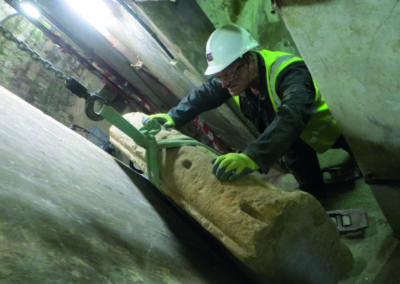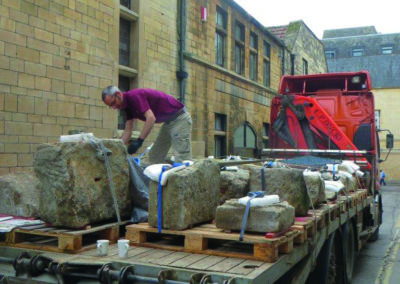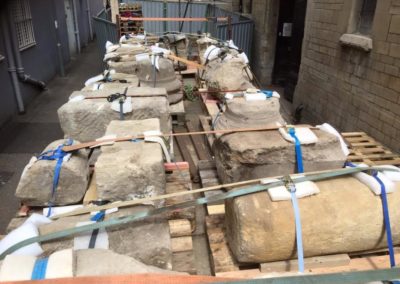THE REMOVAL OF HISTORIC COLLECTIONS AND STORAGE SOLUTIONS
Project overview
The Roman Baths, at the heart of the City of Bath World Heritage Site, consists of the well preserved remains of one of the greatest sacred spas of the ancient world. Maintenance of the infrastructure which supports the heritage site and major tourist attraction is a key activity for the Heritage Services section of Bath & North East Somerset Council.
York Street, which runs alongside this famous tourist attraction, had been assessed by structural engineers, and inherent weaknesses were found. Repairs needed to be carried out to strengthen the supporting structure which meant the subterranean store below the road which held large fragments of Roman Masonry needed to be emptied. Bath & North East Somerset Council appointed Cliveden Conservation to assess, lift, move and transfer the stones from the store into temporary storage.
Summary of conservation work carried out
The removal operation was to be carried out in and amongst the Roman remains lying in passages beneath the road surface of York Street. This area had been used for more than a century to store architectural masonry and Roman stone found on the heritage site. Over 160 stones in a wide range of sizes and shapes with some weighing up to 3/4 of a tonne, all needed to be moved without causing any damage to the archaeological site or the objects themselves.
The logistics of moving heavy objects around this very sensitive site, with very tight spaces to contend with, needed careful planning. Cliveden Conservation constructed a scaffold platform over the sensitive Roman remains within the passages to provide a good solid runway.
By using a combination of both Roman and modern lifting technology, Cliveden Conservation was confident they could create a secure lift without causing any damage. As well as using an electric hoist the conservation team made full use of lewis holes in the Roman stones; these were originally designed to take lewis pins to lift the stones. Cliveden Conservation replicated this traditional technique with some of the stones using modern lewis pins to get an initial lift. Wooden battens were then inserted below the stones before finally wrapping the stones in modern straps for safe lifting and transportation.
The results
The delicate operation of lifting and moving the stones across the specially created scaffold pathway, up through a small staircase and out of the side entrance to the Roman Baths took six weeks. Over 160 pieces of architectural masonry and Roman stone were removed without damage to them or the archaeological site. These stones have now been put into safe storage at Keynsham near Bath, until the essential repairs to York Street have been completed.
Project details
Client:
Bath & North East Somerset Council
Main Contractor:
Cliveden Conservation
Category:
Advisory and material analysis | Stonework
What we did
“The work was carried out in a very constricted and restrictive area of the site, with minimal disruption to our normal operation of the site and no disruption to our visitors. The work was completed very satisfactorily and well ahead of the forecast completion date.”
lain Johnston, Facilities Manager, Heritage Services Bath & North East Somerset Council




